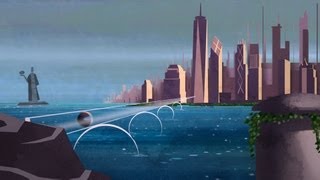(单词翻译:单击)
Today ,more than half of all people in the world live in an urban area.
今天,世界上超过一半的人口是城市居民。
By mid-century, this will increase to 70%.
到本世纪中叶,城市人口将增加到70%。
But as recently as 100 years ago, only two out of ten people lived in a city, and before that, it was even less.
而仅在一百年前,城市人口只占两成,这之前,城市人口更少。
How have we reached such a high degree of urbanization, and what does it mean for our future?
我们怎么会这样高度城市化了呢?高度城市化对我们未来又意味着什么?
In the earliest days of human history, humans were hunter-gatherers, often moving from place to place in search of food.
在人类初期,人是靠打猎和摘果子生存,四处游荡觅食。
But about 10,000 years ago, our ancestors began to learn the secrets of selective breeding and early agricultural techniques.
但是大约一万年前,我们的祖先开始掌握了饲养动物的秘密和早期农耕技术。
For the first time, people could raise food rather than search for it,
人类首次开始生产食物而不再简单寻找食物了。
and this led to the development of semi-permanent villages for the first time in history.
由此,人类历史首次出现了半固定村落。
'Why only semi-permanent?' you might ask.
你可能要问:“怎么还是半固定的呀?”
Well, at first, the villages still had to relocate every few years as the soil became depleted.
那时候,每隔几年,村子就得搬家,因为土地用了几年就会贫瘠。
It was only with the advent of techniques like irrigation and soil tilling about 5,000 years ago
大概五千年前,灌溉和犁地等技术的出现
that people could rely on a steady and long-term supply of food, making permanent settlements possible.
带来了长期、稳定的食物,人类才终于可以长期定居了。
And with the food surpluses that these techniques produced, it was no longer necessary for everyone to farm.
那么,技术带来了食物的盈余,就没必要大家都去农耕。
This allowed the development of other specialized trades, and, by extension, cities.
有人就开始开发别的行业了,进而产生出城市。
With cities now producing surplus food, as well as tools, crafts, and other goods,
因为城市制造了盈余的食物,工具,艺术品等各种商品,
there was now the possibility of commerce and interaction over longer distances.
自然就产生了商业,以及远距离之间的往来。
And as trade flourished, so did technologies that facilitated it, like carts, ships, roads, and ports.
贸易的繁荣,又促使技术突飞猛进,比如有运货马车,轮船,道路,还有港口。

Of course, these things required even more labor to build and maintain,
当然,这些又需要人力修建维护,
so more people were drawn from the countryside to the cities as more jobs and opportunities became available.
引发更多的人离开农村来到城市,因为城市工作机会多。
If you think modern cities are overcrowded,
如果你觉得现在的城市人口过多,
you may be surprised to learn that some cities in 2000 B.C. had population densities nearly twice as high as that of Shanghai or Calcutta.
那我现在告诉你,公元前两千年,有些城市人口密度是上海和加尔各答的两倍。是不是吓了你一跳?
One reason for this was that transportation was not widely available,
那时候人口过密的原因之一是交通不发达,
so everything had to be within walking distance, including the few sources of clean water that existed then.
大家都是靠走路,所以就近才方便,另外干净水源也有限。
And the land area of the city was further restricted by the need for walls to defend against attacks.
那时候,城市的土地类型要考虑到是否适合建城墙以抵御外敌侵犯。
The Roman Empire was able to develop infrastructure to overcome these limitations,
罗马帝国开发出基础设施克服了这些限制,
but other than that, modern cities as we know them, didn't really get their start until the Industrial Revolution,
但除此之外,据我们所知,现代城市是直到工业革命时才终于开始蓬勃发展的,
when new technology deployed on a mass scale allowed cities to expand and integrate further,
当时,新科技的大量采用促进城市的发展和资源整合,
establishing police, fire, and sanitation departments, as well as road networks, and later electricity distribution.
建立了警察局,消防部和卫生部,修建了交通网,而后又有了电供应。
So, what is the future of cities?
那么,未来城市是什么样子呢?
Global population is currently more than 7 billion and is predicted to top out around 10 billion.
目前全球七十多亿人口,而且预计地球最多能承受一百亿人口。
Most of this growth will occur in the urban areas of the world's poorest countries.
人口增长最快的地方将是最贫穷国家的城市区域。
So, how will cities need to change to accommodate this growth?
那么,城市该如何发展以应对激增的人口呢?
First, the world will need to seek ways to provide adequate food, sanitation, and education for all people.
首先,要想办法给所有人提供足够的食物,卫生和教育。
Second, growth will need to happen in a way that does not damage the land
其次,人口增长同时又不能破坏
that provides us with the goods and services that support the human population.
人类赖以生存的、供我们休养生息的土地。
Food production might move to vertical farms and skyscrapers, rooftop gardens, or vacant lots in city centers,
食品制造业大概要搬到垂直牧场和摩天大厦里,屋顶花园里或是市中心的空地上,
while power will increasingly come from multiple sources of renewable energy.
能源使用方面,将会更多采用各个种类的可再生能源。
Instead of single-family homes, more residences will be built vertically.
别墅将越来越少,取而代之的会是更多的高楼大厦。
We may see buildings that contain everything that people need for their daily life,
楼内设施应有尽有,人们日常所需在楼内均可买得,
as well as a smaller, self-sufficient cities focused on local and sustainable production.
也会有小型的、致力于当地可持续发展型的自给自足城市。
The future of cities is diverse, malleable, and creative,
未来城市将是形形色色的、具有可塑性并且别出心裁的,
no longer built around a single industry, but reflecting an increasingly connected and global world.
不再围绕某一行业而建设,而是会反映出日益紧密连接的全球化趋势。


